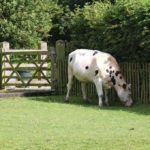A-Z
Charcoal
Charcoal is made by burning wood on a fire that is starved of oxygen. The process drives almost all of the moisture out of the wood, leaving a fuel that is easy to light and burns at a higher temperature than wood does.
Charcoal burning used to be common on the Forest. The wood was stacked in a mound that was covered in turf or clay. A small hole in the covering at the top and at the bottom of the mound was made to allow just enough air to feed the fire without burning the wood completely. Making charcoal was a dirty job, but it was also a skilled one—if you let in too little air you wouldn’t convert the wood into charcoal, and if you let in too much air the wood burned away completely.
Cattle
 Cattle can be turned out onto the Forest by people who have commoning rights. The fee for turning out a cow is the same as the fee for a pony.
Cattle can be turned out onto the Forest by people who have commoning rights. The fee for turning out a cow is the same as the fee for a pony.
The Cattle on the New Forest are generally docile and ignore people but they can become aggressive when they, or their offspring, might be threatened by dogs, so it is always best to keep away from them, as they are big animals and could easily cause serious injury. If you feel threatened and have a dog on a lead, let the dog off the lead, move away and let the dog fend for itself.
Carr
Carr is a type of ground that is turning from a bog to a wood. When the conditions are right, reeds and other tall plants grow in bogs, and over the years the soil formed from dead reeds and plants accumulates, causing the ground level to rise above the surrounding water level of the bog.
Trees such as willow and ash then colonise the new ground, and they cause the ground to dry out further, to the point where other types of trees such as oak and beech can become established.
Camping and caravanning
Camping and caravanning is allowed only on authorised sites in the Forest. At one time you could set-up camp anywhere on the Forest provided you paid for a permit, but so much damage was done by people driving off the tracks that the rules had to be tightened.
In those days the Forest keepers had to collect fees from campers, and would hand out tickets to those who had paid.
Browsing line
Most of the deciduous trees in the open Forest are bare of leaves and twigs below a line about two metres from the ground, because the browsing ponies, deer and cattle keep them stripped. The browsing line is a very noticeable feature of the Forest.

